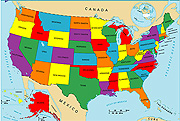- Navigating Your Midlife Crisis: Embracing New Possibilities
- City Raccoons Showing Signs of Domestication
- Mapping the Exposome: Science Broadens Focus to Environmental Disease Triggers
- One Week Less on Social Media Linked to Better Mental Health
- Your Brain Changes in Stages as You Age, Study Finds
- Some Suicide Victims Show No Typical Warning Signs, Study Finds
- ByHeart Formula Faces Lawsuits After Babies Sickened With Botulism
- Switch to Vegan Diet Could Cut Your Greenhouse Gas Emissions in Half
- Regular Bedtime Does Wonders for Blood Pressure
- Dining Alone Could Mean Worse Nutrition for Seniors
Southeastern States Have Highest Rates of Preventable Deaths


People in the southeastern United States have a much greater risk of dying early from any of the nation’s five leading causes of death, federal health officials reported Thursday.
Those living in eight southern states — Alabama, Florida, Georgia, Kentucky, Mississippi, North Carolina, South Carolina and Tennessee — endure 28 percent to 33 percent of all potentially preventable deaths from heart disease, cancer, chronic lower respiratory disease, stroke and unintentional injury, according to U.S. Centers for Disease Control and Prevention estimates.
“This data is yet another demonstration that when it comes to health in this country, your longevity and health are more determined by your ZIP code than they are by your genetic code,” CDC director Dr. Tom Frieden said during a news conference.
The top five causes of death accounted for nearly two-thirds of all U.S. deaths in 2010, and nearly 900,000 Americans die prematurely every year from these causes, the CDC said.
Death rates for each cause of death vary greatly from state to state. So CDC researchers compared all states against the states with the lowest rates of death to estimate how many deaths could be prevented if those low rates were a national trend.
According to the CDC, it should be possible on a national basis to prevent:
- 34 percent of premature deaths from heart disease, prolonging about 92,000 lives.
- 21 percent of premature cancer deaths, prolonging about 84,500 lives.
- 39 percent of premature deaths from chronic lower respiratory diseases, prolonging about 29,000 lives.
- 33 percent of premature stroke deaths, prolonging about 17,000 lives.
- 39 percent of premature deaths from unintentional injuries, prolonging about 37,000 lives.
These numbers are particularly important for the southeastern states, which led the nation with the highest numbers and rates of preventable deaths in all five top causes of death.
The southeastern states have a combination of unhealthy trends that increases the overall risk of premature death, including higher smoking rates, greater obesity rates, lower rates of physical activity and less blood pressure control, Frieden said.
“The Southeast has sometimes been referred to as the ‘Stroke Belt.’ This report confirms that,” he said.
This is the first time that the CDC has attempted to estimate the number of preventable deaths from leading causes of death in the United States, he said.
For each of the top causes of death, there are risk factors that people can reduce by changing their lifestyle or addressing chronic health issues, the CDC said.
Modifiable risk factors include:
- Heart disease: tobacco use, high blood pressure, high cholesterol, type 2 diabetes, poor diet, overweight and lack of physical activity.
- Cancer: tobacco use, poor diet, lack of physical activity, overweight, sun exposure, alcohol, and exposure to certain chemicals and other substances.
- Chronic respiratory disease: tobacco smoke, second-hand smoke exposure, other indoor air pollutants, outdoor air pollutants and allergens.
- Stroke: high blood pressure, high cholesterol, heart disease, diabetes, overweight, tobacco and alcohol use, and lack of physical activity.
- Unintentional injury: lack of seatbelt use, lack of motorcycle helmet use, unsafe consumer products, drug and alcohol use, and unsafe home and community environments.
More information
To read the new report, visit the U.S. Centers for Disease Control and Prevention.
Source: HealthDay
Copyright © 2025 HealthDay. All rights reserved.










